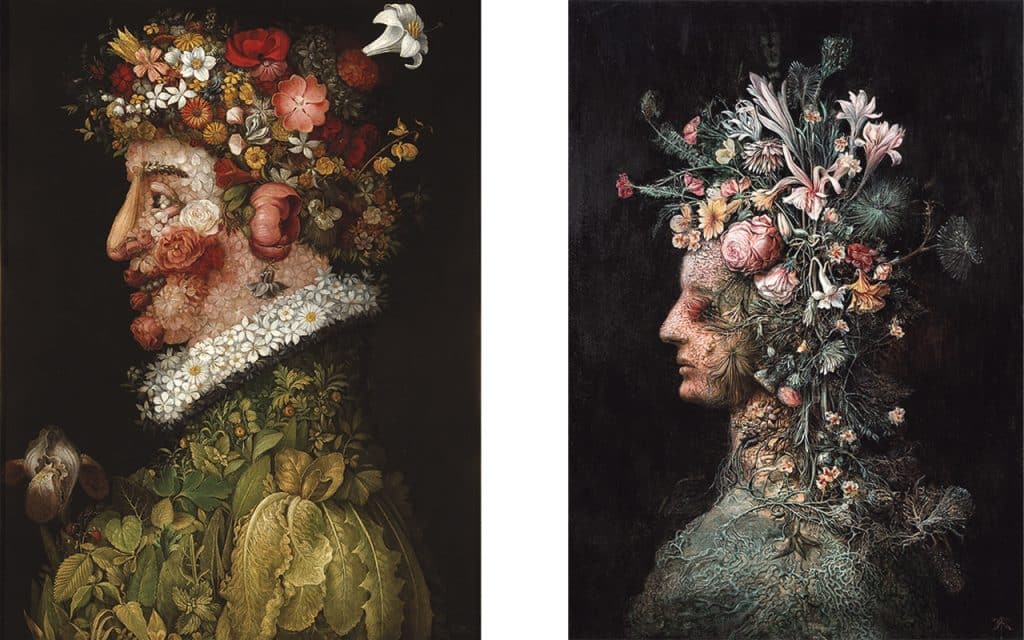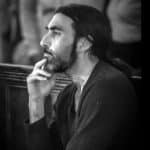
Her mouth is a fish, her cheek a stingray. One octopus nets her fish-and-otter-hair, another comprises her shoulder, whilst an eel forms her neck and a pearl earring dangles from her ear-shell. Who is she? A painting by a surrealist, you might think, someone modern or contemporary? Perhaps Dali or Magritte? In fact, the image is much older, its title, ‘Water,’ painted in 1566 by the Milanese artist, Giuseppe Arcimboldo (1527-1593).
Arcimboldo is a name that few, perhaps, will know. And yet his unique and startling images must have been a hit at the Habsburg court, where he served as court painter to three successive emperors. Indeed, it was the case; so much so, that in 1590, Rudolf II commissioned Arcimboldo to paint him as Vertumnus, the Roman god of the seasons. Ever obliging, Rudolf’s nose became a pear, his cheeks, apples, his forehead, a pumpkin. Some may have thought the completed portrait an improvement, that the sickly emperor had never looked so well. The Emperor, who loved the works of Bosch and Bruegel, must have been delighted.
Was Arcimboldo’s work more than just a curiosity of composites, a game of illusion? Or did it also comprise a satirical edge? Contrary to what one might think, it was not created in a vacuum. The works of Hieronymus Bosch, Pieter Bruegel, Jan Mandijn and their ilk would have been known to the Italian painter. Hybrid creatures and composite forms were popular in Netherlandish culture, and the trade in images via engravings, ensured that well connected artists, such as Arcimboldo, were well aware of the shape-shifting currents of the north.
Even if Arcimboldo’s composite portraits were no more than curiosities, however, the impulse to make one form out of others triggers inevitable thoughts about the interconnectedness of life. Quite literally, ‘we are what we eat,’ but also, more profoundly, that all forms in the cycle of birth and death, are ultimately interchangeable. Rudolf II may have had a unique view on this, as he dabbled in alchemy, and was certainly alive to the mysteries of metamorphosis.
Arcimboldo’s work is also not lost on the painters of today, and has special significance for the contemporary Italian master, also from Milan, Agostino Arrivabene. I have written about Arrivabene before; in his painterly world, faces and bodies are interpenetrated by and submerged in, organic matter: green shoots, flowers, mycelium, blood vessels, molluscs and coral. Penetration, decomposition and metamorphosis are the keynotes of Arrivabene’s visual language.
In a work titled ‘L’erbario. Omaggio alla primavera di Giuseppe Arcimboldo’ (The Herbarium. Homage to Spring, by Giuseppe Arcimboldo), 2025, Arrivabene re-invents Arcimboldo’s composite personification of Spring within his own fantastic idiom and lexicon. It is a homage Arrivabene has arrived at naturally and forms part of a series of like-paintings, exhibited this year at the Primo Marella Gallery, in Lugano, Switzerland. It is worth here quoting the artist, as his commentary on the work is quite profound:
“If one were to seek in modern painting an arcane awakening of Arcimboldo – far from any postmodern caricature or mannerist jest–one would need to turn to this nocturnal figure, where the flower is not ornament but oracle, flesh and the very tongue of metamorphosis. I’ve composed, or rather recomposed, the iconography of Arcimboldo’s Primavera–today housed in the Louvre–not as pastime or variation, but as profound infraction, as an act of melancholic clairvoyance.” (@primomarellagallery)
There are many things one can say about Arrivabene’s commentary, and the series of related paintings. Firstly, we are in no doubt here that Arrivabene’s work is far more than a curiosity. His figures and faces are never composites, but interpenetrated beings, out of, and through which, grow, bloom and die a myriad of vegetal and boreal forms. His works titled ‘Il Foliato’, ‘La Fiorita,’ and ‘Homo Salvatico in plenilunio,’ 2025, breathe autumnal and wintry decay, the bodies and faces exploding with stems, roots, vessels, curling leaves and withering flowers. Arrivabene transcends Arcimboldo, absorbs the Renaissance painter into his own inner library of references, whilst nodding to him as a forebear, a link in the chain of symbol and consciousness. This is, as Arrivabene says, “profound infracture,” an incisive term for the awakening of one awareness within another. It is a timely phrase, backed up by powerfully grounded painting, at a time when many new realists appropriate the surface of past images without interrogating their core.
What, one wonders, would Rudolf II have thought of the contemporary Milanese painter? An emperor enamoured of the arts, who dabbled in alchemy and sought, like all alchemists for the ‘materia prima,’ the prized substance which forever eluded the alchemists’ vials. I believe he would have been riveted, would have felt Arrivabene on the cusp of some great secret, a secret whispered, however, to the eyes alone.
I can just see him there in his gallery, where he was said to gaze at a single work for hours, stroking his cat, roaring for something to ease his unruly chest, and gazing at Arcimboldo’s Primavera, as, flower by flower, it faded to become the painter’s personification of Autumn, and finally his painting of Winter. Little did he know that out of that final darkness Arrivabene’s vision would one day be born.



